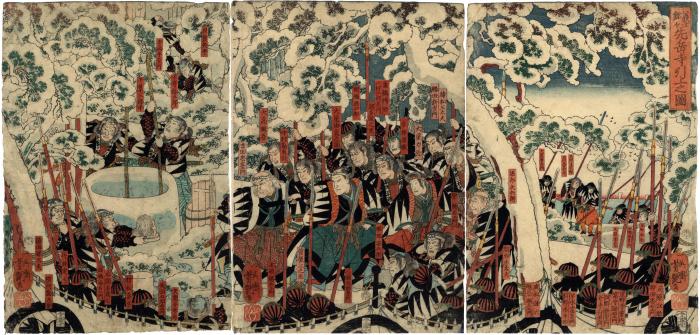Utagawa Yoshitsuya (歌川芳艶) (artist 1822 – 1866)
The Loyal Retainers withdraw to Sengaku-ji (Gishi meimei Sengaku-ji hikiage no zu - 義士銘々先岳寺引上之図)
10/1860
9.875 in x 14 in (Overall dimensions) Japanese woodblock print
Signed: Ichieisai Yoshitsuya ga
一英斎芳艶画
Artist's seal: kiri Publisher: Tsujiokaya Bunsuke
(Marks 548 - seal 23-066)
Combined date and aratame censor's seal: 10/1860
Museum of Fine Arts, Boston
Ritsumeikan University - right panel
Ritsumeikan University - middle panel
Ritsumeikan University - left panel On the night of January 30, 1703, by the modern Western calendar, the 47 rōnin planned their attack on the stronghold of their enemy Kira, the man who caused their master to commit suicide. "Clad in black coats resembling those of firefighters, with white cloth bands sewn around their sleeves to avoid friendly fire in the dark, the ronin proceeded to Kira’s residence.... the ronin split into two groups — one entering Kira’s front gate, the other from the rear. After two hours of fighting, the ronin achieved their goal before dawn. As Kira’s retainers were caught off guard, no ronin were killed in the attack; whereas they slayed 17 of Kira’s men and wounded 28. From Kira’s house, Oishi’s squad went to Sengakuji Temple near Shinagawa, where their master was enshrined, and offered Kira’s head.... After paying homage at Sengakuji, the remaining 46 ronin turned themselves over in an orderly manner to shogunate authorities. The news immediately spread throughout Edo; the public and the samurai class alike, including Shogun Tsunayoshi, praised their prowess and their loyalty to their lord."
12 days after the attack the first play appeared. Three days later it was repressed by the shogunate which feared other incitements. However, the story by then was too well know to be censored completely, and many versions appeared in the kabuki theater, puppet plays, prints, and after the advent of movies, in the cinema and eventually on television.
The information and quotes come directly from an article in the Japan Times article by Masaru Fujimoto on December 15, 2002.
****
18 figures on the right-hand panel
1) 前原江助 (Maehara Kosuke?)
2) 押田忠右エ門
3) 早野和助 (Hayano Wasuke)
4) 片岡源五右エ門 (Gengoemon Kataoka)
5) 尾野寺重内 (Onodera Shigeuchi ?)
6) 富守助右エ門
7) 矢間喜兵衛
8) 岡野新右エ門
9) 斧寺行右エ門
10) 早水当左エ門 (Hayami Tozaemon)
11) 杉野市平治
12) 矢間進太郎
13) 木村尾賀右エ門
14) 大星勢左エ門
15) 鹿松諌六
16) 磯貝十郎左エ門
17) 堀部矢兵衛
18) 間瀬忠太夫 (Mase Chūdayū [Masaaki])
Figures in the center panel
1) The older, balding man in the lower left is Yoshida Chūzaemon (Kanesuke) - 吉田 忠左エ門
2) The one behind him is Ōtaka Gengo - 大高現吾
3) The next ronin to the right is Nakamura Kansuke - 中村勘屓計
4) Ōboshi Yuranosuke -大星由良之助
5) Miura Jiroemon Kanetsune - 三浦治郎左エ門
6) Sugenoya San'nojō - 菅屋三之丞
[The rest will be added later.]
****
At the time of this event Sengaku-ji, in the Honjo district, was considered to be in the outskirts of Edo. This was the family temple of the Asano family and is where the Loyal Retainers delivered the severed head of their master's enemy, Kira, to his grave.
****
The dentate pattern on this print is a give away that it is a Chūshingura-themed prints. But not all prints devoted to this story show these designs. "The distinctive dentate pattern on the coats is an iconographical motif which represents the inescapable progress of day and night, symbolizing unfailing loyalty."
Quoted from: 'Mitate kokkei Chūshingura. Hiroshige's humorous parodies of the Loyal Retainers' by Pierre Wijermans and Henk Herwig, fn. 32, p. 73.
Tsujiokaya Bunsuke (辻岡屋文助) (publisher)
Chūshingura (忠臣蔵 - 47 Rōnin) (genre)
